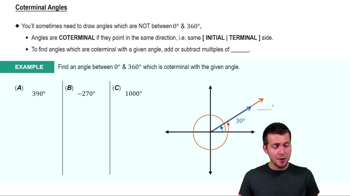Textbook Question
Determine whether each pair of vectors is orthogonal.
〈1, 1〉, 〈1, -1〉
255
views
 Verified step by step guidance
Verified step by step guidance



Determine whether each pair of vectors is orthogonal.
〈1, 1〉, 〈1, -1〉
Determine whether each pair of vectors is orthogonal.
√5i - 2j, -5i + 2 √5j
Determine whether each pair of vectors is orthogonal.
i + 3√2j, 6i - √2j
Refer to vectors a through h below. Make a copy or a sketch of each vector, and then draw a sketch to represent each of the following. For example, find a + e by placing a and e so that their initial points coincide. Then use the parallelogram rule to find the resultant, as shown in the figure on the right.
<IMAGE>
a + b
Determine the number of triangles ABC possible with the given parts.
c = 50, b = 61, C = 58°
Find the length of the remaining side of each triangle. Do not use a calculator.
<IMAGE>